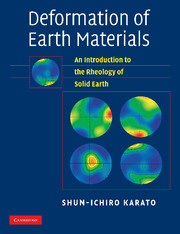Book contents
- Frontmatter
- Contents
- Preface
- Part I General background
- Part II Materials science of deformation
- 4 Elasticity
- 5 Crystalline defects
- 6 Experimental techniques for study of plastic deformation
- 7 Brittle deformation, brittle–plastic and brittle–ductile transition
- 8 Diffusion and diffusional creep
- 9 Dislocation creep
- 10 Effects of pressure and water
- 11 Physical mechanisms of seismic wave attenuation
- 12 Deformation of multi-phase materials
- 13 Grain size
- 14 Lattice-preferred orientation
- 15 Effects of phase transformations
- 16 Stability and localization of deformation
- Part III Geological and geophysical applications
- References
- Materials index
- Subject index
- Plate section
15 - Effects of phase transformations
Published online by Cambridge University Press: 05 June 2012
- Frontmatter
- Contents
- Preface
- Part I General background
- Part II Materials science of deformation
- 4 Elasticity
- 5 Crystalline defects
- 6 Experimental techniques for study of plastic deformation
- 7 Brittle deformation, brittle–plastic and brittle–ductile transition
- 8 Diffusion and diffusional creep
- 9 Dislocation creep
- 10 Effects of pressure and water
- 11 Physical mechanisms of seismic wave attenuation
- 12 Deformation of multi-phase materials
- 13 Grain size
- 14 Lattice-preferred orientation
- 15 Effects of phase transformations
- 16 Stability and localization of deformation
- Part III Geological and geophysical applications
- References
- Materials index
- Subject index
- Plate section
Summary
Phase transformations occur in many regions in Earth (particularly in the transition zone, 410–660 km depth in the mantle) and have several important effects on plastic properties. A phase transformation changes crystal structure and the nature of the chemical bonding that affects any physical properties including plastic properties. In addition, a first-order phase transformation results in a change in grain size and a redistribution of internal stress–strain that may influence the nature of plastic deformation. A second-order phase transformation will not result in these changes, but will result in the anomalous reduction of an elastic constant and/or the anomalous increase in the dielectric constant. All of these changes have certain effects on rheological properties. This chapter presents a summary of the experimental observations and theoretical models on which one can estimate the relative importance of various effects in geological processes.
Key words isomechanical group, transformation plasticity, Greenwood–Johnson model, Poirier model, grain-size reduction.
Introduction
Phase transformations of materials occur in Earth's interior. The most important ones are those that occur in the mantle transition zone (410–660 km; see Chapter 17), but phase transformations also occur in the crust and the upper mantle, and perhaps in the lower mantle. A phase transformation affects the rheological properties in a variety of ways. (1) A phase transformation results in a different crystal structure and chemical bonding, which will modify all the properties including the rheological properties (crystal structure, chemical bonding effects).
- Type
- Chapter
- Information
- Deformation of Earth MaterialsAn Introduction to the Rheology of Solid Earth, pp. 271 - 287Publisher: Cambridge University PressPrint publication year: 2008



